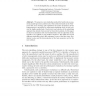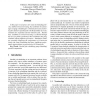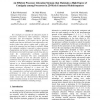223 search results - page 1 / 45 » Improving First-Come-First-Serve Job Scheduling by Gang Sche... |
JSSPP
1998
Springer
13 years 9 months ago
1998
Springer
Abstract. We present a new scheduling method for batch jobs on massively parallel processor architectures. This method is based on the First
EUROPAR
2008
Springer
13 years 7 months ago
2008
Springer
We describe a scheduling technique in which estimated job runtimes and estimated resource availability are used to efficiently distribute workloads across a homogeneous grid of res...
IPPS
2000
IEEE
13 years 9 months ago
2000
IEEE
In this paper we propose a new class of scheduling policies, dubbed Concurrent Gang, that combines the advantages of gang scheduling for communication and synchronization intensiv...
AICCSA
2007
IEEE
13 years 9 months ago
2007
IEEE
Two strategies are used for the allocation of jobs to processors connected by mesh topologies: contiguous allocation and non-contiguous allocation. In noncontiguous allocation, a ...
PDPTA
2004
13 years 6 months ago
2004
Abstract Computational Grids consist of a multitude of geographically distributed resources. The co-allocation of several of those resources allows for the execution of highly comp...



